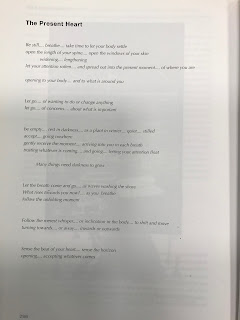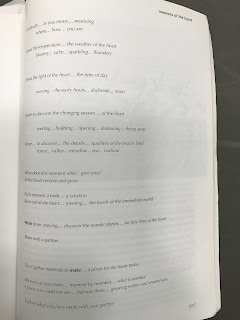Workshop One B - 22/11/17
Body Awareness
How does the body feel with the highs and lows of breathe?
The aim my workshop B is to explore the lows of breathe, relating back to my sub-question of how the body reacts to the highs and lows of breathe. Choosing this as the second workshop will allow for my body to become in tune with the air flowing around it, what happens to body parts when you focus in on where your breathe is travelling and how it can move individual parts such as fingers, toes, an arm or the back.
Research
Discovering the method of how to become aware of the lows of breathe within the body meant searching for a way that allows for total relaxation and mindfulness so that all energy could be concentrated on how what was happening with the air inside.
I recalled back to a lesson we had once where we laid on the floor and listened to someone reading passages out of a book which broke down the outside world and zoned in on yourself and what you were physically feeling at that moment. Within the lesson whilst the book was being read there were moments when breathing was the most important element and you had to fully connect to your breathe which is an extremely effective way to explore the lows of breathe within the body.
After doing some investigating in to ways of relaxing the body I found the book ‘Movement Medicine: How to awaken, dance and live your dreams’.

The section describes a way of letting your body become connected to the ground and the weight of the body by becoming physically aware of what every part of the body is doing, what it is feeling. The text goes on to say "My heart was beginning to to relax inside my dancing body and I found I could breathe deeply." (Darling Khan S, Darling Kahn Y, 2009) this made me consider the intention of the task and how to implement this method of relaxation to exercise how the body moves when truly breathing deeply and sensing the breathe
After speaking to my tutor I discovered the book 'A widening Field:Journeys in Body and Imagination' by Miranda Tufnell and Chris Crickmay where I found two sections that linked back to my aim of exploring the lows of breathe within the body.
(Tufnell M, Crickmay C, 2004, A Widening Field: Journeys in Body and Imagination, Dance, pg 286, pg287)
Plan
This workshop will be One hour and half.
Task One- The first twenty minutes will be spent,laid on the floor in an empty studio, listening to the recording of the passages out of 'A Widening Field: Journeys in Body and Imagination', spending the time when there is not instruction or words being spoken from my recording to connect with the surroundings, the air I am inhaling and exhaling. Try to sense the movement of air within the body, where it is flowing with every breathe and if it moves any body parts.
- Taking a couple of minutes to note down how I felt during task one so that when I reflect back I can see clearly what my bodies response was with it being so fresh in the body.
-Turn on the camera to record first improvisation.
Task Two- Begin movement improvisation when in this state to explore the quality and how the body moves/what it is capable of when feeling that way. Spend as long on this improvisation as needed so that when it feels natural to come to a stop, or when a set of movements stand.
-Turn off camera, and similar to Workshop One A, watch improvisation to recognize any particular moves that are interesting and highlight the intention of the workshop.
Task Three- Spend the rest of the time to take the interesting points of movement from the improvisation and use trial and error to create a phrase.
-Turn on camera to record phrase.
Evaluation
The process of using body awareness and using the book 'A Widening Field: Journeys in Body and Imagination' by Miranda Tufnell and Chris Chrickmay, was very effective in terms of of finding the connection between the body and breathe. Taking the time to zone in and focus on where the breathe was coming from, where it moved internally and how that made my body feel when going to improvise. These were my feelings I managed to write down straight after the process of task One so that I could be as specific to how my body felt within the task as possible.
Feelings from Task One:
- Chest raising up and down significantly.
- Head becomes filled with air.
- Can feel it flowing through my face, the nose, under my eyes, around past the temples.
- Feel it running down my back of neck to my spine, shivering feeling.
- Moves my fingers, slight wiggle individually.
- Moment of flowing in the legs, mainly the lower leg towards the ankle which shifted the ankle.
- Can feel the air in the toes, wiggling them moving the air around.
- Pelvis feel heavy.
- Shoulders expanding and retracting when exhaling and inhaling.
The improvisation was difficult as I found it hard to emulate exactly how the body felt in response to the body awareness task with it being such a relaxed and calm situation. Annalysing the improvisation went well, this is because although within the improvisation the movement was very stop start, I could see elements where I was more in touch with my breathe and the air moving through certain parts of the body which allowed me to select sections that I felt I could create a phrase from.
Task Three- Phrase One
Task Three was to take moves from my improvisation and use trial and error to create a phrase. This was challenging as I wanted to capture the essence of my sub-question as much as possible therefore, after I had created my phrase I decided I would spend another workshop to develop this phrase further. I made this decision to look at this phrase further in my next workshop because after watching it I did not feel it was linking clearly to my sub-question or how I felt within Task One.
Research
Discovering the method of how to become aware of the lows of breathe within the body meant searching for a way that allows for total relaxation and mindfulness so that all energy could be concentrated on how what was happening with the air inside.
I recalled back to a lesson we had once where we laid on the floor and listened to someone reading passages out of a book which broke down the outside world and zoned in on yourself and what you were physically feeling at that moment. Within the lesson whilst the book was being read there were moments when breathing was the most important element and you had to fully connect to your breathe which is an extremely effective way to explore the lows of breathe within the body.
After doing some investigating in to ways of relaxing the body I found the book ‘Movement Medicine: How to awaken, dance and live your dreams’.
(Darling Khan S, Darling Kahn Y, 2009, Movement medicine: How to awaken, dance and live your dreams, Hay House, London)
The section describes a way of letting your body become connected to the ground and the weight of the body by becoming physically aware of what every part of the body is doing, what it is feeling. The text goes on to say "My heart was beginning to to relax inside my dancing body and I found I could breathe deeply." (Darling Khan S, Darling Kahn Y, 2009) this made me consider the intention of the task and how to implement this method of relaxation to exercise how the body moves when truly breathing deeply and sensing the breathe
(Tufnell M, Crickmay C, 2004, A Widening Field: Journeys in Body and Imagination, Dance, pg 286, pg287)
Plan
This workshop will be One hour and half.
Task One- The first twenty minutes will be spent,laid on the floor in an empty studio, listening to the recording of the passages out of 'A Widening Field: Journeys in Body and Imagination', spending the time when there is not instruction or words being spoken from my recording to connect with the surroundings, the air I am inhaling and exhaling. Try to sense the movement of air within the body, where it is flowing with every breathe and if it moves any body parts.
- Taking a couple of minutes to note down how I felt during task one so that when I reflect back I can see clearly what my bodies response was with it being so fresh in the body.
-Turn on the camera to record first improvisation.
Task Two- Begin movement improvisation when in this state to explore the quality and how the body moves/what it is capable of when feeling that way. Spend as long on this improvisation as needed so that when it feels natural to come to a stop, or when a set of movements stand.
-Turn off camera, and similar to Workshop One A, watch improvisation to recognize any particular moves that are interesting and highlight the intention of the workshop.
Task Three- Spend the rest of the time to take the interesting points of movement from the improvisation and use trial and error to create a phrase.
-Turn on camera to record phrase.
Evaluation
The process of using body awareness and using the book 'A Widening Field: Journeys in Body and Imagination' by Miranda Tufnell and Chris Chrickmay, was very effective in terms of of finding the connection between the body and breathe. Taking the time to zone in and focus on where the breathe was coming from, where it moved internally and how that made my body feel when going to improvise. These were my feelings I managed to write down straight after the process of task One so that I could be as specific to how my body felt within the task as possible.
Feelings from Task One:
- Chest raising up and down significantly.
- Head becomes filled with air.
- Can feel it flowing through my face, the nose, under my eyes, around past the temples.
- Feel it running down my back of neck to my spine, shivering feeling.
- Moves my fingers, slight wiggle individually.
- Moment of flowing in the legs, mainly the lower leg towards the ankle which shifted the ankle.
- Can feel the air in the toes, wiggling them moving the air around.
- Pelvis feel heavy.
- Shoulders expanding and retracting when exhaling and inhaling.
The improvisation was difficult as I found it hard to emulate exactly how the body felt in response to the body awareness task with it being such a relaxed and calm situation. Annalysing the improvisation went well, this is because although within the improvisation the movement was very stop start, I could see elements where I was more in touch with my breathe and the air moving through certain parts of the body which allowed me to select sections that I felt I could create a phrase from.
Task Three- Phrase One
Floor Phrase
Task Three was to take moves from my improvisation and use trial and error to create a phrase. This was challenging as I wanted to capture the essence of my sub-question as much as possible therefore, after I had created my phrase I decided I would spend another workshop to develop this phrase further. I made this decision to look at this phrase further in my next workshop because after watching it I did not feel it was linking clearly to my sub-question or how I felt within Task One.



Comments
Post a Comment